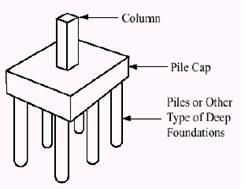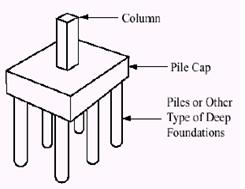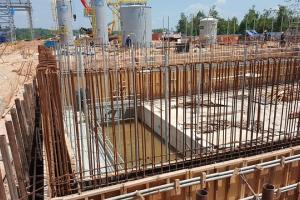Types of Foundations & Methods of Construction of Foundations

Following are some of the major types of foundations and foundation construction methods:
Shallow Foundations :
Foundations provided immediately beneath the lowest part of the structure, near the ground level are known as shallow foundations. Such foundations are mostly placed on the first hard and firm strata available below the ground level. Shallow foundations are further classified into the following types:
- Spread footing or open trench foundations
- Grillage foundations
- Raft foundations
- Stepped foundations
- Inverted arch foundations
1) Spread Footing Foundations :
Foundations constructed by increasing the area at the base of the structure by means of offsets are called spread footing foundations. In such foundations, the spread is given under the base of a wall or a column by providing offsets. This spread is known as footing and the foundation itself is called spread footing.
![]() See Also: Why to Lay Foundation? | Bearing Capacity Stress Analysis | Retaining Wall
See Also: Why to Lay Foundation? | Bearing Capacity Stress Analysis | Retaining Wall
Broadly speaking, all types of shallow foundations can be referred to as spread footing foundations. However, from a design and construction point of view, they have been designated separately. The various types of spread footing foundations are ;
a) Wall footings:

This is a common and the simplest type of spread footing foundation; It consists of a number of courses of bricks, the lowest being usually twice the thickness of the wall above. In this type of foundation, the base width of the wall is increased by providing 5cm (one-fourth of brick length) offsets on either side of the wall. The depth of each course is usually 10 cm
In some cases, however, the bottom course is made 20cm deep. In the case of footing for store walls, the size of the offset is slightly more than that of the brick wall footing.
Method of Construction of Wall Footing:
For constructing wall footing, a bed of lean cement concrete (1:8:16) is first laid over the entire length of the wall. The thickness of this lean concrete bed is usually kept 15cm and its width is kept 20 to 30 cm more than that of the bottom course.
In no case, the depth of the concrete bed should be less than its projection beyond the wall base. For foundations over firm soil or compacted ground, the concrete bed below the brick wall footing may be dispensed with. After laying the concrete for constructing the concrete bed, it should be properly compacted and cured before laying the base course of the wall.
Suitability:
This is the cheapest type of spread footing foundation and is largely used for walls of ordinary buildings.
b) Masonry Pillar Footing:
Isolated footings are used to support the individual pillars and columns constructed in brick or stone masonry. They are stepped down in the wall footing after providing a 15cm offset of foundation concrete on all sides.
c) Concrete Column Footing:
These are either stepped type, slate type, or slope type, having projections in concrete. To support heavy loads, reinforcement is also provided at the base. The reinforcement provided is in the form of steel bars and is placed in both directions. Concrete column footings may be either isolated footings or combined footings. Isolated footings are used to support the individual columns, whereas combined footings are used where projections of different columns are not possible on all sides, due to limited space.
The combined footings are generally rectangular in shape when both columns are of the same sections and trapezoidal in shape when the columns are of different sections.

2) Grillage Foundation:
The foundation which consists of one or two tiers of wooden or rolled steel section with space filled up with concrete is known as the Grillage foundation. This is so called because the bed constructed in this type of foundation is called grillage. This type of construction avoids deep excavation and provides the necessary area at the base of the structure to reduce the intensity of pressure within the safe bearing capacity of the soil.
OBJECT :
The object of this type of foundation is to spread the load over a large horizontal area at the base of a structure.
Types of Grillage Foundation
Depending upon the material used in construction, grillage foundations are further classified into two types.
- Steel Grillage Foundation
- Timber Grillage Foundation
Steel Grillage Foundation
Method of construction of steel grillage foundation:
- For constructing a steel grillage foundation, a trench is excavated to the calculated width and about 0.90 m - 1.50 m deep. The bottom of the trench is rammed and leveled.
- Then a layer of lean cement concrete (1: 8: 16), about 30cm thick, is laid and compacted.
- After this, a layer of rich cement concrete (1: 2:4 ), about 15cm thick is spread and compacted to form a concrete bed.
- Over the concrete bed thus prepared, the bottom tier consisting of a number of steel I - beams of designed dimensions are placed at a specified distance apart, using spacer bars. The space in between and around the steel beams is then filled with cement concrete.
- On this bottom tier, a second layer of steel I - beam is placed if required.
- The entire space is then filled with cement concrete 1: 2: 4. On the grillage bed thus prepared, the structure in the form of a steel stanchion, column, and pier is built.
For timber grillage foundation construction
- Wooden planks, usually 5 to 8 cm in thickness, are laid side by side longitudinally on the prepared bed of the trench excavated for this purpose.
- The planks should be arranged in a width of 45 to 60 cm more on either side than the designed width of the base course of the structure.
- On this bottom layer of planks, rectangular timber sections of suitable size are laid at about 35 cm from center to center.
- Then a top layer of planks, usually 8 to 10 cm in thickness, arranged side by side, in width equal to that of the base course of the structure is to be built over it
- On the timber platform thus prepared, the structure in the form of a timber column or even a masonry wall is built.
Suitability of steel grillage foundation:
Steel grillage foundations are useful for structures like columns, piers, and stanchions subjected to heavy concentrated loads and hence are employed for foundations of the buildings such as theaters, factories, towns, halls, etc. Timber grillage foundations are usually provided for timber columns subjected to heavy concentrated loads. This type of grillage foundation can also be safely used for light buildings where the soil encountered is soft and permanently water-logged.
3) RAFT FOUNDATION :
The foundation consisting of a thick R.C.C. slab covering the whole area of a mat is known as a raft foundation.
Method of construction of Raft Foundation:
- In Raft Foundation construction the whole area is dug out to the specified depth and 30 cm wider than the area to be covered.
- The bed is compacted and sprinkled with water.
- Then a layer of lime concrete or lean concrete ( 1: 8: 16 ) is laid to a suitable thickness to act as a bottom cover.
- After this, the reinforcement is laid. The reinforcement consists of closely spaced bars placed at right angles to one another.
- Then the cement concrete (1 : 2: 4 ) is laid and compacted to the required thickness.
- The concrete slab so laid is then properly cured
- When loads are excessive, thick concrete beams running under the columns can also be constructed.
SUITABILITY :

This type of foundation is useful for public buildings, office buildings, school buildings, residential quarters, etc, where the ground conditions are very poor and the bearing power of the soil is so low that individual spread footing cannot be provided.
4) STEPPED FOUNDATION :
Another type of foundation is a stepped foundation, For Stepped Foundation Construction, excavation is done in steps having a short length and uniform thickness, and the masonry work is done on the horizontal bed of concrete thus prepared.
If there is any possibility of slipping off the structure bodily, R.C.C piles can be driven along its base concrete on the sloping side.
5) INVERTED ARCH FOUNDATION :
The foundation consisting of inverted arches between the piers is known as an inverted arch foundation. In this type of foundation, the load from the piers is transferred to the soil by constructing arches in an inverted position at their base. The rise of the inverted arches is about one-fifth to one-tenth of the span and they are usually built in half-brick rings. The position of arches may be either along the row of piers or across the row of piers in both directions depending upon the nature of the soil and the type of land to be taken by them.
METHOD OF CONSTRUCTION:
For constructing this type of foundation;
- Excavation is done to the required depth.
- The bottom of the excavation is leveled and compacted
- Then the foundation concrete is laid to the required thickness and finished according to the layout of the arches to be constructed under the piers.
- The arch rings, usually half brick thick, are then built in cement mortar and piers are constructed.
- The end piers should be designed and constructed to take the outward thrust caused by arch action.
SUITABILITY :
This foundation is not commonly used for buildings, but it is quite suitable for other structures like bridges, reservoirs, tanks, supports for drainage lines, etc.
DEEP FOUNDATION:
The foundation constructed sufficiently below ground level with some artificial arrangements such as piles, wells, etc, at their base are called deep foundations. Deep foundations are further classified into the following types ;
- Pile foundation
- Well foundation
- Caisson foundation
1) PILE FOUNDATION:

A foundation (spread footing or grillage) supported on piles is called a pile foundation. A pile foundation usually consists of a base of spread footing or grillage supported by piles at their bottom. Piles distribute a load of the structure to the soil in contact either by friction alone or by friction combined with bearing at their ends.
SUITABILITY :
This type of foundation is suitable for the following situations ;
- When the soil is very soft and a solid base is not available at a reasonable depth to keep the bearing power within safe limits.
- When the grillage and raft foundation is very expansive.
- When the building is very high carrying heavy concentrated loads.
- When it is necessary to construct a building along the seashore or riverbed









